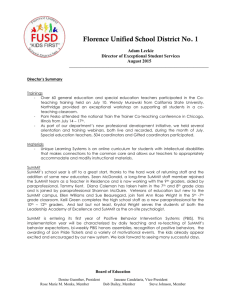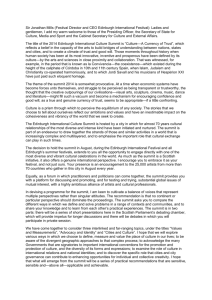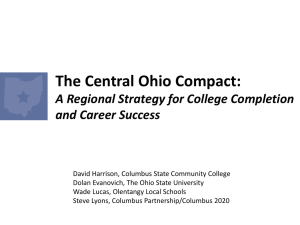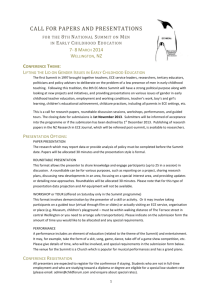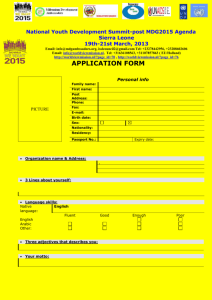Conservation-Summit-Initiative-Case-Studies-Peer-Review-June
advertisement
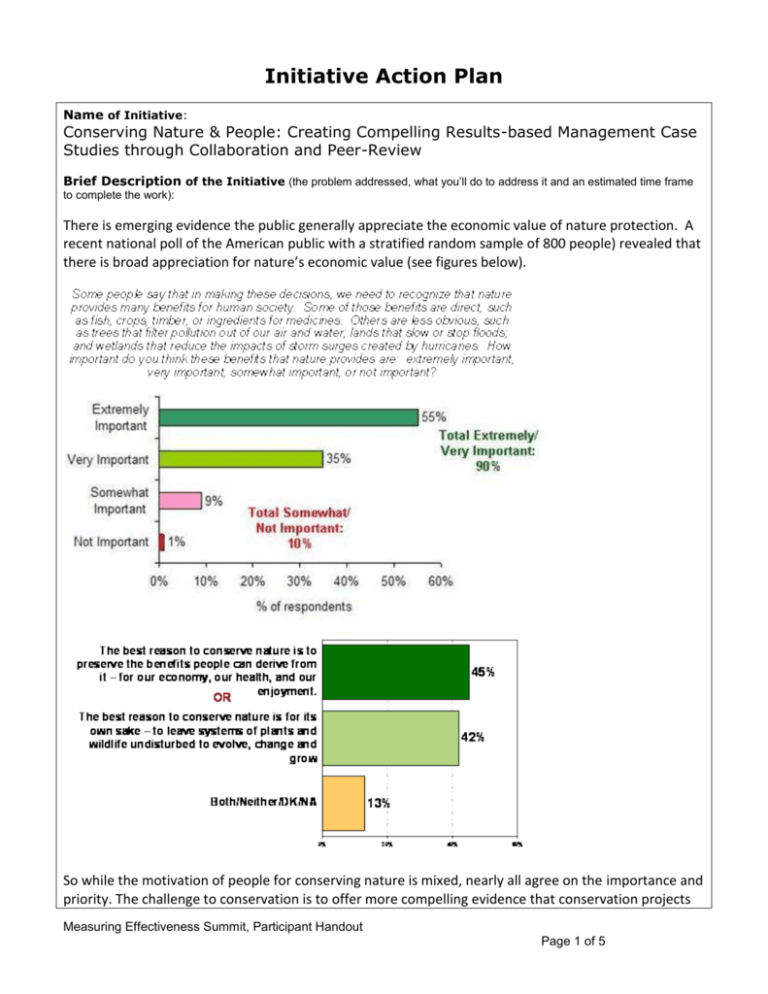
Initiative Action Plan Name of Initiative: Conserving Nature & People: Creating Compelling Results-based Management Case Studies through Collaboration and Peer-Review Brief Description of the Initiative (the problem addressed, what you’ll do to address it and an estimated time frame to complete the work): There is emerging evidence the public generally appreciate the economic value of nature protection. A recent national poll of the American public with a stratified random sample of 800 people) revealed that there is broad appreciation for nature’s economic value (see figures below). So while the motivation of people for conserving nature is mixed, nearly all agree on the importance and priority. The challenge to conservation is to offer more compelling evidence that conservation projects Measuring Effectiveness Summit, Participant Handout Page 1 of 5 actually deliver these benefits to people. We will implement a series of case study measures programs that allow us to determine whether or not conservation makes a difference to the health of the environment as well as human well-being measures, such as household income or community engagement. This will require collection of data from a social science perspective, which is generally lacking in conservation. The results will be open access using a tool such as The Nature Conservancy’s Conservation Project (ConPro) web database, and will be shared with the world at a Measures Summit II. Data that link conservation to improved human well-being are lacking and this initiative promises to both develop methods for collecting such data, and translate that data into stories that inform program managers, policy leaders and thought advancers. We propose using a formal peer review process among project teams to improve these case study projects. We propose two peer review periods. The first peer review would take place in October or November 2011 to evaluate the overall project design and provide feedback on the underlying theory of change and selection of strategies and actions. The second peer review would occur two months before the scheduling of the next Measuring Effectiveness Summit to evaluate the monitoring design. It may take several years before the results from these peer-reviewed case studies generate truly compelling stories in terms of biodiversity and human well-being outcomes. However, even interim results will be effective if they are supported with solid action and measuring effectiveness plans, establishment of baseline measurements, and implementation of a transparent, regular reporting process to share intermediate results. These case studies will make good “bright spots” at the 2011 Measuring Effectiveness Summit. The case studies can then be heavily publicized through public media outlets, publications, and websites. Key Outcome(s) Expected (if the Initiative will last more than 1 year, include 1 year outcomes) 1 year outcome: 3-5 compelling case studies demonstrating effective results-based management approaches for conserving nature and people. Longer term outcome: Adoption of results-based management practices showing nature conservation and human well-being results on 100’s of projects based on communication and marketing of case studies. Preliminary Thoughts on HOW you’ll measure success of the Initiative Number of completed case studies that fully meet specific criteria for results-based management Number of media stories featuring the case studies Number of hits on case study website Number of times case studies are referenced in other project plans and publications Key Stakeholders (those who will need to adopt, support or implement this Initiative, have impact on its success) Staff assigned to coordinate this initiative (i.e., handle the request for proposals, proposal review, peer-review process, preparation for 2011 Summit). Project staff from selected case study The Team Key Responsibility If determined, Current Members Dan Salzer, TNC Peter Kareiva, TNC Jim Boyd, Resources for the Future Ruth Bowman, Margaret A. Cargill Philanthropies Members we want to add, invite to join us. Measuring Effectiveness Summit, Participant Handout Page 2 of 5 projects. Communication and marketing staff Planned Integration, Communication with other Community Measures Collaborate with members of the conservation effectiveness training initiative to offer training and support to case study project staff Other implementing organizations and funders Sponsor(s) of the Team To be determined Key Resources Needed (technological, financial, human capital, other sponsorship) Funding needs still to be determined. Some funds to go directly to the case study projects (e.g., 5% of the overall project costs to support measuring effectiveness efforts). Participating NGO’s should cover at least 50% of the measuring effectiveness costs. Some additional funds will be needed to cover coordination costs to manage this initiative and collaboration costs (e.g., peer review meetings, peer exchanges) and for marketing and communication efforts. Measuring Effectiveness Summit, Participant Handout Page 3 of 5 A Preliminary Theory of Change for the Initiative The conservation community of practice currently lacks compelling examples that demonstrate the applied value of results-based management practices for achieving biodiversity AND human well-being results Collaboration among implementing conservation organizations and funders in selecting, supporting, peer-reviewing, and improving results-based management practices for a set of highprofile case studies will lead to influential, powerful stories of why projects should improve their effectiveness measures practices. Widespread marketing of stories from a set of compelling examples will catalyze interest and adoption in applying improved results-based management practices. Key Actions Identify the key actions you will take to achieve success on this Initiative. Focus particularly on how you will LAUNCH this Initiative to mobilize your team to move forward and the actions/next steps you’ll take in the next 3 months. Include the first meeting/call/activity you’ll do following the Summit. Identify the other major activities you’ll do over the lifetime of the Initiative. Completed by Who’s Responsible Submit initiative outline to other team members from breakout session at the Moore Summit for review, edit, additions May 9, 2010 - Done- Dan Salzer Initiative description submitted to the Measuring Effectiveness Summit organizing committee May 11, 2010 - Done- Dan Salzer The case study initiative is bundled with other initiatives in follow-up communication to all Moore Summit participants Summit Coordinating Committee Send invitation to 2010 Summit funders to gauge interest in contributing to the case study grant fund and to implementing organizations to gauge interest in: (a) Joining the Initiative Case Study Working Group; and (b) Submitting proposals to participate in this initiative Summit Coordinating Committee Reach Go – No-Go decision on moving forward with this initiative based on securing a commitment from funders to fund the case study grants and interest from implementing organizations Summit Coordinating Committee Develop and circulate a request for proposals and establish a grant review process Case Study Working Group Deadline for submitting proposals Project staff of implementing organizations Proposals selected for funding September 2010 Case Study Working Group Peer review meeting (following a written peer reviews process) to evaluate theory of change behind conservation actions November 2010 Case Study Working Group Peer review meeting (following a written peer reviews process) to evaluate plans for measuring the effectiveness of conservation actions 2 months prior to 2011 Summit Case Study Working Group 2011 Measuring Effectiveness Summit May/June 2011 Case Study Working Group Outreach and communications efforts Following Summit Case Study Working Group Measuring Effectiveness Summit, Participant Handout Page 4 of 5 Team members that developed this Initiative are: Dan Salzer, The Nature Conservancy Peter Kareiva, The Nature Conservancy Jim Boyd, Resources for the Future Ruth Bowman, Margaret A. Cargill Philanthropies Measuring Effectiveness Summit, Participant Handout Page 5 of 5
